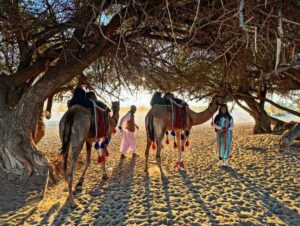The 3,000km Trans-Himalyan run that ultra-runner Peter Van Geit completed last summer was not enough for him. To finish 2019, he decided on an imaginative challenge that only someone very familiar with India would think of: climb 200 Shivaji forts along the length of the Western Ghats. He called his new project the Trans-Sahyadri; Sahyadri is another term for the Western Ghats.
The Shivaji forts were built in the 16th century under Chhatrpati Shivaji Maharaj. A warrior king, he established India’s first navy to protect the coast of what is now the state of Maharashtra. As part of his strategy, he erected forts along the mountains through the Western Ghats and Konkan coast. These forts looked down from almost unreachable aeries on steep rock faces and cliffs, which gave the high ground over invading forces. He built approximately 360 forts in all.
Peter Van Geit has lived in India for the last two decades, but it wasn’t until earlier in 2019, while giving a talk in Mumbai about his Trans-Himalayan journey, that a friend introduced him to some of the forts. This gave him the idea for a new challenge. After discovering that there were hundreds of such forts, he wondered if he could put together a big map linking all of them. Several months later, he had such a map, with GPS routes to 200 forts.

The 200 forts in Maharashtra. Image: Peter Van Geit
Since the forts were over such a huge area, and his time was limited, Van Geit decided to run the 500km linking the first 50 forts, then motorbike to the remaining 150. As nearly all of the forts stood atop mountains, he had to summit the peaks to reach them.

Day 1: Lonavla to Dhak Buddhist Caves. Photo: Peter Van Geit
The 500km run followed a picturesque, largely uninhabited route from Lonavala to Mahabaleshwar. A major feature called the Deccan ridge runs through the Western Ghats at an altitude of 600 to 1000m. “In many places,” Van Geit said, “I was running on trails with the forest on my right side and a 500m drop down to the Konkan plains on my left.”

Kiresh to Kalsubai. Photo: Peter Van Geit
Attacking the journey at an incredible rate, the Belgian covered up to eight forts per day, though he averaged three or four. How many he did depended on the difficulty of the climbs and the distances between them. As usual, he ran in a minimalist style, but he brought even less than he did in the Himalaya because the tropical rainforest climate was gentler and the altitude lower.
“I was just carrying a 10-litre backpack with my sleeping mat, bivy and a lightweight summer sleeping bag,” he said. “I only used the bivy when it was windy or in the jungles to protect myself from snakes and insects.” Despite the remoteness, Van Geit frequently passed through villages, so didn’t carry much food or water.
He cited the monsoon as one of his main difficulties. Usually, the deluge ends in September, but it continued for an extra month this year, so he was frequently soaked. “As you climb the steps cut in the rocks, there is no railing or protection, so if you slip, you will fall a few hundred metres,” he said. “After five months of rain, the rock is covered in green moss, which makes it scary, no matter which shoes you use.”

Photo: Peter Van Geit
Sometimes, he struggled to follow the ancient, unused routes through dense vegetation. His GPS failed regularly in these remote regions, forcing Van Geit to find his own way. “For 95 percent of the forts, a little searching was involved,” he said. “If you lost the trail, you might start slipping on those steep slopes, because even though the path is ancient and only two or three feet wide, it was hard to find a foothold without it.”
Once, when traversing from Pune to Mahabaleshwar, Van Geit found himself stuck on one side of Khrishna Lake, with no trails to the other side, where his next fort was located. In true explorer style, he tied his minimal gear to his dry bag and swam the kilometre to the far side.

Khrishna Lake. Photo: Peter Van Geit
After the first 50 forts, he transitioned to a motorbike, traveling at night and covering his forts during the day, between catnaps.
The historical element made this trip about more than endurance. The patience and ancient technology required to build these precarious constructions amazed him. “On some of the forts, you had steps cut into an almost 30m deep corridor in the rock,” he said. It would have taken those past peoples months or years of labor.

Ratangad Fort. Photo: Peter Van Geit
The local people near the forts were openly excited about his interest in their heritage. “Although Chhatrpati Shivaji Maharaj, who built the forts, didn’t have a huge army, he was a very strategic guy,” said Van Geit. “Today, he is a hero, a God almost to the local people, who see the forts almost as temples.”

Photo: Peter Van Geit
Van Geit notched his 200th fort just before Christmas, but he does not plan to relax in 2020. Already he’s drafting his next project, to cross 100 mountain passes. “For me, it’s about going to remote places where I find my inner peace,” he says.
His website features a complete list of the forts and regions he covered.






